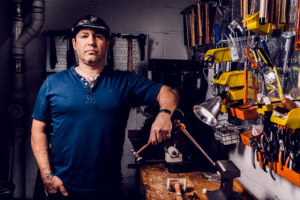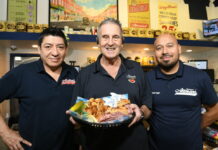
One day, remembering a college friend who sometimes bent cafeteria forks into crude bracelets, Doug Heifetz picked up a fork and gave it a try. Those first few twists soon turned into a serious hobby, then a new profession.
“I think it was partly about creating these surprising transformations that people hadn’t seen before,” he said. “Transforming materials from one thing to another, but in a way that each piece can tell its own story.”
Someone sees a bracelet or a ring, but on second glance, the tines of a fork or the handle of a spoon become apparent. One object has become another.
In a similar way, the Silver Spring-based artist went from being a rabbi to a silversmith.
“Transformation is one of the main themes of my work,” Heifetz said. “And [transformation] also describes me in some ways and also describes my goals for the world.”
While he continues to serve an area congregation on a part-time basis, Heifetz focuses his time and creativity on artistic pursuits. At Lost & Forged, his one-person workshop, he hand-crafts jewelry, home décor items and Judaica from reclaimed vintage materials, especially silverware. Each ring, bracelet, necklace, money clip or candlestick has a story to tell.
“The word metalsmith comes from Germanic language roots,” he explained. “It means ‘to hit’ or ‘one who strikes metal’ and when you strike metal against something, it takes the shape of whatever metal you’re striking against.” And, because particularly silver is relatively malleable, the craftsman added, “Sometimes I just shape it with my hands and fingers.”
His process begins with used sterling and silver-plated tableware—forks, spoons, knives—or occasionally other materials like motorcycle or car fender trim, which is aluminum.
While he usually takes time to plan each piece, Heifetz incorporates a sense of playful improvisation in many of the finished works.
“By the time I start to work on something, I usually have a plan that comes from examining it. And most of my work has a little bit of an improvised feel. I like to think that there’s something of a MacGyver-like quality: like I’m using something that was intended for one thing, but I’m repurposing it for something very different. That’s part of the fun.”
He shops for popular silver patterns, often featuring floral or leaf patterns, to keep on hand. Finding the cutlery and stones has been made easy, he said, by the many online sites like eBay and Etsy selling estate-sale-like items. He never attends estate sales or antique shops, finding them far too time consuming. Finished spoon rings—his most popular item—range in price from $30 up to thousands of dollars, depending on materials and stones as well as the complexity of the design.
Some of the most meaningful works Heifetz has created include one-of-a-kind commissions. Many people have inherited a relative’s old silver, and in today’s more casual entertaining era, using formal place settings have gone out of style. Besides, who wants to spend time polishing all those filigreed handles of spoons, forks and knives? Lost & Forged can be a great way to repurpose dusty and tarnished family heirlooms resulting in everyone receiving a custom piece of grandma’s silver—as a ring, pendant, money clip or watchband. Because every piece is handmade, Heifetz can also engrave messages or a meaningful date inside a ring, and each piece is sized to fit.
“Often the value of the silver is in its connection to family history,” he said of the commissions he fulfills. “It may or may not have financial value—sometimes it does, but sometimes it doesn’t—either way the main value is in its connection to the family’s story.
“I find inspiration for my own creative work [from] just the idea of digging into the past and finding a way to work with it to make it more relevant,” he said. “While this job is not at all the same as being a congregational rabbi, I see a shared perspective there—a shared impulse to dig into the past and find ways to make [these creations] relevant for the present and the future.”
A St. Louis native, Heifetz came to the Washington region to attend Georgetown University. He studied in the School of Foreign Service while also delving into Jewish texts on campus and independently. “But I knew early on that I didn’t want to be in the foreign service.”
In 2005, following rabbinic ordination, he spent 11 years as a full-time rabbi at Oseh Shalom Synagogue in Laurel. There he found fulfillment working with congregants, but “I had this wellspring of creativity I was in touch with that was leading me in independent, artistic and entrepreneurial directions that were just different from what the congregation needed,” Heifetz said. “I didn’t want to neglect the congregation’s needs, and I also didn’t want to neglect this element of my life that was really starting to bubble up in important and meaningful ways for me.”
He doesn’t refer to this work as recycling—although in its reuse of materials it is environmentally sustainable. “I want my work to actually tell the story of its own
transformation.”
To learn more, visit lostandforged.com.




